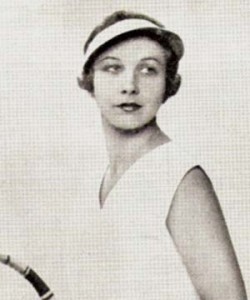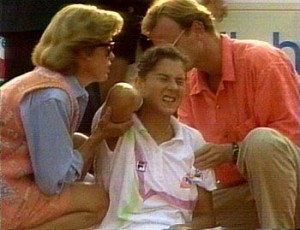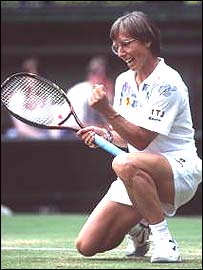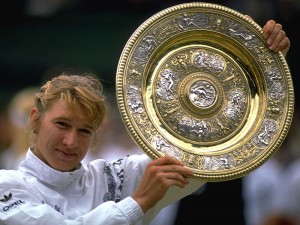Queens of the Court 1

Helen Wills Moody
Our Queens of the Court Series spans about 100 years, from someone who was born in 1884, to someone who was stabbed on court in 1993. Below please find links to the Queens of the Court series:

Helen Wills Moody
Our Queens of the Court Series spans about 100 years, from someone who was born in 1884, to someone who was stabbed on court in 1993. Below please find links to the Queens of the Court series:

It is hard not to wonder just how great Monica Seles could have been were it not for the attack in Hamburg.
Monica Seles, a former world No. 1 tennis player, released her memoir Getting A Grip: On My Body, My Mind, My Self on April 21, 2009.
The autobiography details her bout with depression and her subsequent food addiction after being stabbed in a tennis tournament in Germany.
It also describes dealing with her father’s cancer diagnosis and eventual death, which devastated a daughter who was very close to her dad. Finally it follows her journey back to the game and her aim for a life beyond tennis.
Later on July 11, 2009, Seles was inducted into the International Tennis Hall of Fame, drawing attention to her story by a generation of tennis fans who may have missed her extraordinary rise to the top of the women’s game in the ’90s.
The Early Years
Monica Seles was born in Novi Sad, Yugoslavia on Dec. 2, 1973 but she became a naturalized citizen of the United States in 1994. She started playing tennis when she was five years of age.
Her father, Karoly Seles, coached her and was the one who helped her develop her unique two-handed style with both the forehand and the backhand. He also contrived special moments that made the day-to-day practices fun for the little girl.
She was one of many tennis talents discovered and developed by Nick Bollettieri, training in the Bollettieri Tennis Academy for two years. Read the rest of this entry →

Martina Navratilova dominated women's tennis for more than a decade.
Her achievements on the tennis court are almost without parallel.
Her energy in supporting the rights of others has been a constant.
Her passion for the sport that she says “gave her a soul” is unquestioned.
Yet it is one particular interview, following one particularly unlikely event in this tennis icon’s life, that throws as much light on her character as any of those achievements.
Martina Navratilova was a surprise participant, and a surprisingly popular finalist, in the 2008 television show “I’m a Celebrity…Get Me Out Of Here.” And in an interview for the U.K.’s revered Times newspaper, she admitted it was simply the challenge that made her sign up.
“I want challenges, whether cerebral or physical…If you never push yourself, you won’t know what your point of failure is. People always said I was so competitive. Not with other people, with myself.”
This gets to the heart of what made Navratilova one of the most successful women ever to pick up a tennis racket: the need to prove to both herself and the world what was possible.
However, there is a second quote that gets to the heart of what makes her such an enduring, respected, and important woman beyond the tennis court.
“If I feel strongly, I say it. I know I can do more good by being vocal than by staying quiet. I’d have a whole lot more money if I lied, but I wouldn’t have enjoyed spending it.”
This is the story of a courageous, feisty, and generous woman who also happened to challenge political repression and personal prejudice on her way to becoming one of the world’s greatest living athletes.
“You can’t live in the past.”
Navratilova was born in October 1956, in Prague, Czechoslovakia, but her ski-instructor father and her mother divorced when she was still very young.
Tennis ran in her family. Her grandmother had been an international player and, when her mother remarried in 1962, her stepfather became her coach.
By the age of eight, Navratilova reached the semifinals of her first tournament, and her talent began to attract the attention of the Czech authorities.
In 1972, age 15, Navratilova won the Czech national tennis championships. The next year, she reached the quarterfinals of the French Open and the third round of Wimbledon. Read the rest of this entry →

Always keeping her eye on the prize, Chris Evert won at least one major for 13 straight years.
As half of one of the greatest sports rivalries of all time, Chris Evert is probably the “half” less appreciated today.
Her battles with Martina Navratilova grew to legendary status as they met so often in the finals of majors. The fact that Navratilova’s career extended years beyond Evert’s is the reason the Czech-American is better known today.
Evert was a powerful baseline player and Navratilova had the ultimate serve and volley game. They battled during an era when these two playing styles clashed on tennis courts around the world.
But there was something else different between these two champions—their on court demeanor and individual personalities were as opposite as night and day.
The one thing they did share in common was an ultimate drive and a fervent determination to be the No. 1 tennis player in the world.
Knowing her, you have to believe that when Christine “Chris” Marie Evert was born on Dec. 21, 1954, she must have come into the world with a tennis racket clutched in her tiny little hand. Thank goodness her mother never had to endure such a handicap. Mom simply had to contend with family members whose lives revolved around the sport. Read the rest of this entry →

Seven of Steffi Graf's 22 career Grand Slam titles came at Wimbledon.
“Will you marry me?” someone called from the stands.
“How much money do you have?” was Steffi’s gravely delivered response, eyes fixed upon her opponent across the net.
The crowd erupted in laughter. It was Wimbledon, and a crowd, and player, not given to much jocularity. She’d been dating race car driver, Michael Bartels, for years, with no indication that anything more serious was coming out of it. It was an impertinent question, an improbable response, and so hugely funny at the time.
For me as a casual spectator (watching it on TV, from the horizontal position on the couch, no less), it was the first indication that the serious, un-smiling, un-’gamine,’ Steffi Graf might be interested in more than crushing opponents with hard-core resolve; be more than merely stoic in demeanor.
Stefanie Marie Graf. Born June 14, 1969. One of a few well-beloved living legends of this, or any, sport. Arguably the greatest woman’s champion of all time. She turned pro at age 13, at age 19 she completed one of the feats of all sports, a Golden Slam – a calendar year Grand Slam of tennis majors and an Olympic Gold medal (1988 – Sydney), that is only a part of her legend.
She retired in 1999, after almost 17 years in the sport, with a total of 22 major titles, second only in history to Margaret Court’s astounding 24.
What distinguished her (see summary at the end of the article), was ability on all surfaces. Some tennis players are grass court specialists (with a minor on hardcourts), for example. Not Steffi. She had terrific ability on all surfaces.

Margaret Smith Court stills holds the record for most Grand Slam singles titles (24) and most overall Grand Slam titles (62).
Let’s start at the top. There is, for Margaret Court more than any other player—man or woman—no other place to begin. For Court stands at the very top of tennis’ list of achievements.
Try this. She won a total of 62 Grand Slam titles: next in line is Martina Navratilova with 59, and both outstrip the next, Billie Jean King, at a mere 39. (The top man? Roy Emerson with 28.)
What about this? Twenty-four singles Slams: next in line is Steffi Graf at 22. (Roger Federer is way out of contention with his 15.)
Look at another. Court is the only person to win all 12 Slams at least twice. In fact, take out Wimbledon’s results (where she won only three singles and two women’s doubles), and she won the other 10 Slams at least four times.
And one more for good measure. Court is one of only three players to achieve a career “boxed set”—all three titles at all four Slams.
Not enough? Well, Court is one of only three women to win a calendar Slam (in 1970), and on four further occasions, she won three singles Slams in the same year.
Make no mistake, this woman dominates the record books now just as much as she dominated the opposition during her 17-year career.
While you absorb those statistics, consider this, too.
Between 1970 and 1975, the Australian Open did not hold a mixed doubles competition, and in 1965 and 1969, the mixed finals were abandoned due to bad weather (and Court was lined up to play in both). So it’s entirely possible that this remarkable woman could have won another half dozen Slams. Imagine it: 67 titles.